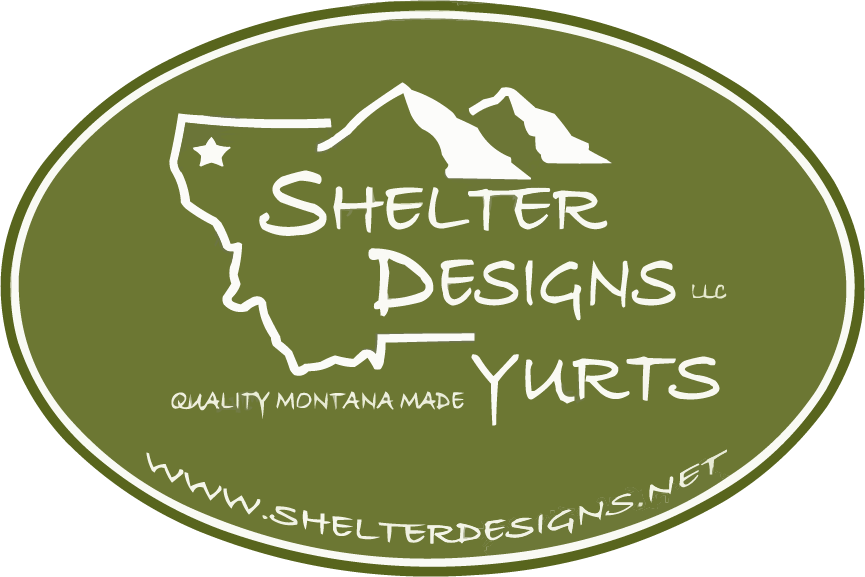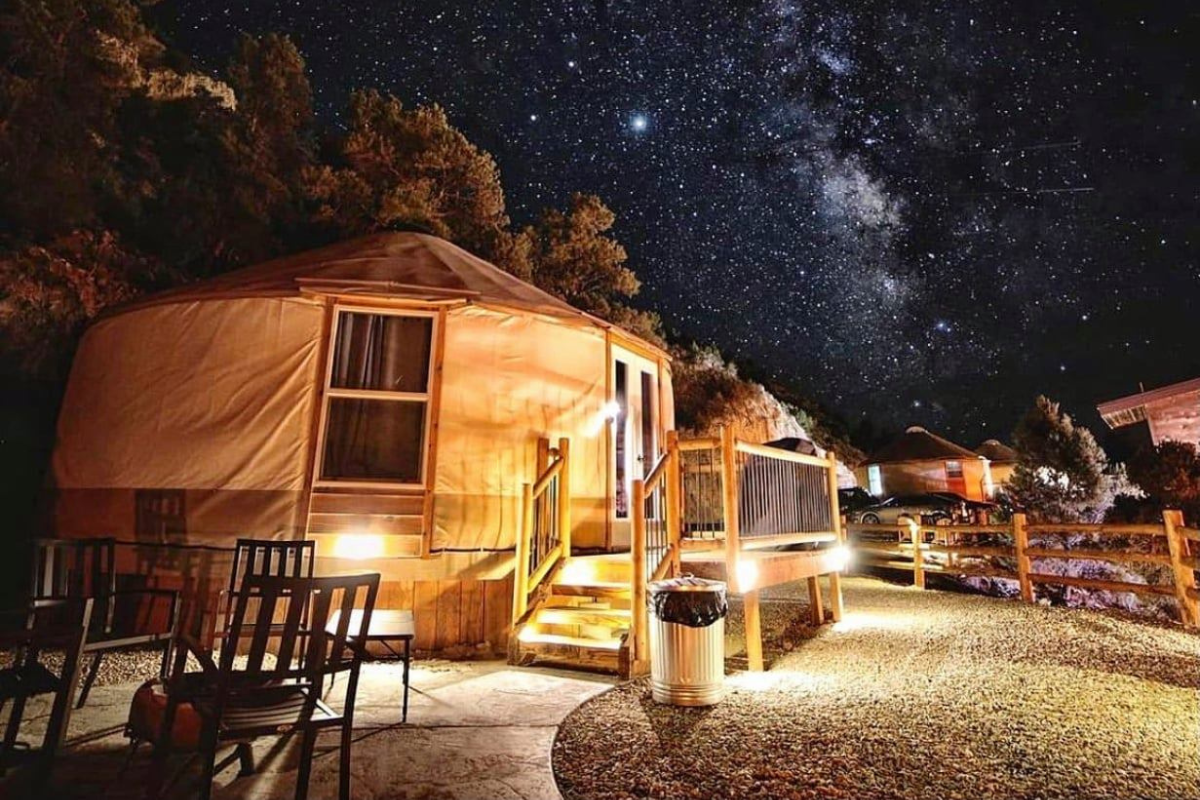Thinking about buying a yurt? At Shelter Designs, we help people choose the right yurt every day. The choice usually comes down to two factors: the type of yurt (fabric vs. wood) and your intended use and climate.
This guide breaks down what to consider before you order:
How to Choose the Perfect Yurt for Your Needs
Fabric Yurts vs. Wooden Yurts
We know that trying to buy a yurt can be a daunting task and we’re here to help. When looking for a yurt for sale, there are some important factors to consider like whether to get fabric or wood. Both styles of yurts operate under the same engineering principles of tension and compression. So, what separates them from each other? The main differences are cost, insulation, portability, and assembly.
Here’s a quick breakdown:
- Fabric Yurt
- Designed for portability and easier disassembly
- Lower initial cost
- Can be insulated, but not to the same degree as a wooden yurt
- A good choice if you may move it or use it seasonally
- Wooden Yurt
- Built for permanence and strength
- Comparable insulation potential to stick-built structures
- Higher initial cost, but longer-term durability
- Ideal for extreme climates and year-round living
To learn more about the differences between wooden and fabric yurts, check out our blog Wooden vs. Fabric Yurts: What You Need to Know.

Yurts for Summer vs. Winter
Summer Tips: Ventilation and Cooling
Maintaining a cool and comfortable living area as well as keeping out moisture can present a bit of a challenge in variable climates. Keep in mind that yurts require more energy to heat and cool compared to the normal homes most of us are used to.
Nonetheless, we have folks living in our yurts in a variety of climates around the world. For those who live in hot and humid areas, we recommend:
- Select multiple operable thermal pane glass windows and an operable tinted dome to maximize circulation and ventilation in your yurt. Framed-in glass windows allow you to install a window-mounted AC unit and the tinted dome provides a significant shield from the hot summer sun.
- Utilize dehumidifiers.
- Install one or more multi-directional fans in your yurt to help draw out hot air and moisture from the yurt. We offer a fan mount that connects to your compression ring, or you can install fans directly onto your roof rafters.
- Additionally, we have seen folks install louver vents in the floor to draw up cool air from beneath the yurt.
Winter Tips: Heating and Insulation
With our Arctic Insulation and a well-insulated subfloor, it is completely possible to live comfortably in cold climates all around the world. For those living in such climates, we recommend:
- Consider a secondary heat source, like a thermostat-controlled heater to supplement a wood stove.
- Going with a slightly smaller yurt or yurts to maximize energy and heat efficiency.
- Purchase a heat source that is rated for double the square footage of the yurt.

Popular Yurt Models for Sale
With decades of experience in yurt design and building, we have narrowed our selection down to two options — The Big Sky Yurt and Eco Yurt.
Big Sky Yurt
The Big Sky Yurt provides everything that you might need in a circular structure. Ranging from 12’ to an epic 40’, this option provides a solution for anybody wanting to buy a yurt. The Big Sky includes many high-quality features and a variety of options for customization. This is our most popular model for a reason and what we recommend most of the time.
Best used as a permanent structure, the Big Sky model is suited for areas that experience heavy snowfall and extreme weather.
Standard Features
- Douglas Fir and Larch lumber for roof rafters and snow/wind legs
- Customizable roof rafters suited to the environment where your custom yurt will be located
- 3/8” heavy-duty tension cable made of galvanized steel
- Insulated fiberglass doors
- Door awning and rain diverters in entry
- Starfire 5-year wall fabric and ProShield 8-year roof fabric
- Removable vinyl windows with bug screens and storm flaps
- Fixed clear dome on roof
Eco Yurt
On the other hand, our Eco Yurt provides an option for those who want to buy a yurt that’s affordable and solution-driven. A handcrafted masterpiece up to 30′, the Eco Yurt is a great choice for those who want an environmentally-friendly yurt for a temporary or permanent structure in the right place.
Standard Features
- Lodgepole Pine roof rafters and snow/wind legs
- Non-toxic food grade tung oil wood finish
- Wall lattice with a finish height of 7′-2″
- 3/8” Heavy Duty Tension cable of high-quality galvanized steel
- Insulated fiberglass door with a thermal pane window
- Door awning and rain diverter on entryways
- StarFire 5-year wall fabric and ProShield 8-year roof fabric
- Removable vinyl windows with bug screens and storm flaps
- Fixed clear dome on roof
Key Takeaways Before Buying a Yurt
- Decide whether you want a permanent structure (wooden yurt) or something more flexible and portable (fabric yurt).
- Factor in climate, cold regions require stronger insulation, while hot climates benefit from more ventilation.
- Consider your intended use: seasonal retreat, full-time home, or studio/workspace.
- Budget for site prep, platform/foundation, and utilities in addition to the yurt itself.
Found the perfect yurt for sale and looking for a place to put it? Check out our blog on Yurt Site Selection for the best information from the experts. If you’re still looking for your dream yurt, our yurt calculator will help you start budgeting!
Frequently Asked Questions About Buying A Yurt
What is the difference between a wooden yurt and a fabric yurt?
Wooden yurts are permanent, stick-built structures with traditional insulation for extreme weather, while fabric yurts are portable, pre-insulated, and easy to assemble. Cost, insulation, portability, and assembly are the main differences.
Can I live in a yurt year-round in hot or cold climates?
Yes. For hot climates, operable windows, tinted domes, fans, and dehumidifiers help maintain comfort. In cold climates, Arctic insulation, well-insulated subfloors, secondary heat sources, and appropriately sized yurts make year-round living possible.
Which yurt is better for winter weather?
The Big Sky Yurt is ideal for areas with heavy snowfall and extreme weather because of its customizable roof rafters, insulated doors, and strong support structure. Proper insulation and heating make it suitable for winter climates.
Are yurts energy-efficient?
Energy efficiency depends on the yurt type, size, insulation, and climate. Wooden yurts with modern insulation perform like a stick-built home, while fabric yurts are efficient for portable or temporary setups with proper insulation and ventilation adjustments.
What are the standard features of a Big Sky Yurt?
Big Sky Yurts include Douglas Fir and Larch roof rafters, galvanized steel tension cables, insulated fiberglass doors, roof dome, Starfire wall fabric, ProShield roof fabric, removable vinyl windows with screens, and door awnings with rain diverters.
What are the standard features of an Eco Yurt?
Eco Yurts feature Lodgepole Pine roof rafters, non-toxic wood finish, 7′-2″ wall lattice, galvanized steel tension cables, insulated fiberglass door with thermal pane window, removable vinyl windows with screens, fixed roof dome, and durable Starfire wall and ProShield roof fabric.
Can I customize my yurt?
Yes. Both Big Sky Yurts and Eco Yurts offer options for roof rafter configurations, window placement, door styles, and interior finishes to match your site conditions and personal preferences.


